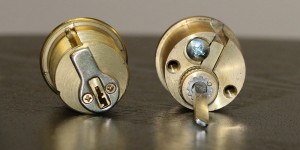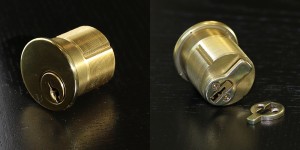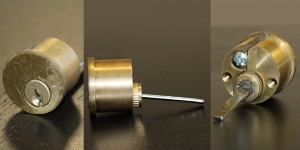 On first glance, a rim cylinder may appear no different from a mortise cylinder. It can take some inspection in order to figure out just what type of lock you are working with. While installed, these cylinders look very similar. They come in similar sizes and often have a trim piece that keeps them secure against torsion attacks. In order to tell the difference, we will need to examine what the locks look like when they are not installed, and how they appear once they are in use. Knowing what type of lock you have will help you to assess your protection, as well as give you the information needed to make adjustments and replace faulty equipment.
On first glance, a rim cylinder may appear no different from a mortise cylinder. It can take some inspection in order to figure out just what type of lock you are working with. While installed, these cylinders look very similar. They come in similar sizes and often have a trim piece that keeps them secure against torsion attacks. In order to tell the difference, we will need to examine what the locks look like when they are not installed, and how they appear once they are in use. Knowing what type of lock you have will help you to assess your protection, as well as give you the information needed to make adjustments and replace faulty equipment.
Traits of a Mortise Cylinder
-
Threading
The cylinder will have threading the outside of the device, which is similar to the threads on a screw. In order to secure it, you will have to rotate the device so that it threads into the corresponding grooves on the lock body. Other than the rotation of the lock cylinder, there is nothing else that is fastening it to the lock body. Nothing will need to be done on the other side of the door. Once you have oriented the cylinder by screwing it in, the lock will function.
-
Cam
The tailpiece for a mortise cylinder is flush against the back of the lock. Most often it will have a circular shape with a small rectangle coming out of it (resembling a flat Ping-Pong paddle). The round section will be fastened onto the cylinder with screws. When the plug is rotated, the rectangular end will move and open the lock. A downward turn of the cam unlocks the device by depressing a button within the lock body. The depression of that button is what opens the lock. The existence of a cam is apparent if the removed cylinder can rest flat with the keyway pointing up toward the sky/ceiling.
-
Interior Lock body
The lock body of a mortise cylinder is its greatest defining characteristic. The name mortise refers to a hole, or recess, which is designed to fit a corresponding piece. In the case of a mortise lock, this hole is cut into the side of the door to fit the mortise lock body. The size and shape relation of the mortise resembles a VHS tape. In the event that the allusion to antiquated technology does not paint the picture, take a look at the door when it is open. Examine the length of the door that lines up with the strike plate. More specifically investigate where the deadbolt and/or latch bolt extends from. If the size of the faceplate is approximately the size of your hand then that is an indication that it uses a mortise cylinder. For glass doors, your mortise may use an Adams Rite deadlatch. The mortise, in this case, will be significantly smaller, not in length, or height, but in width. The main takeaway is that the lock body resides inside the mortise of the door.
Traits of a Rim Cylinder
-
Mounting Bolts
Two bolts secure the cylinder to a thin metal plate located on the other side of the door. This requires you to slide in the lock from the front and then fasten the bolts from the other side of the door. Without these two screws, the cylinder would simply slip out of the door. The metal along the outside of the cylinder will also be smooth, as opposed to the threaded nature of the mortise cylinder.
-
Stem
The tailpiece is a thin length of metal that protrudes from the back of the lock further into the door. The metal extends out. It is not flat against the back of the cylinder. This piece is referred to as a stem. The stem is rotated by turning the correct key in the cylinder. A rotation of the stem through the door will unlock the device. Do to the length of the stem it is not possible to rest the lock with its keyway facing upwards to the sky/ceiling.
-
Exterior Lock body
In the case of a rim cylinder, the lock body is going to rest outside of the door. This may be in the form of a panic bar, exit bar, or some other form of exterior unit. The panic bar or exit bar are the most common devices for a rim cylinder to be fixed to in a commercial setting. Other exterior units are often found on homes or residential doors. Because the tailpiece of the rim cylinder goes straight through the door, if there is a panic bar directly behind the cylinder, then this is a strong indication that the lock you are dealing with is a rim cylinder. For further clarification on what a panic bar is, it is the horizontal length of metal that you push to open a door. A part of the metal will depress (like a large button), and that will retract the latch bolt and leave the door free to open. The key factor about a rim cylinder lock body is that they are found outside of the door.
Conclusion
The main difference between the two cylinders is the tailpieces and how they fit into the lock. Mortise cylinders have a threaded exterior and a cam. And rim cylinders have bolts and a stem that projects out into the door. Besides that, mortise lock bodies fit inside the door, and the lock bodies of rim cylinders can be found on the outside of the door. There are exceptions to these distinctions, but in most instances, this should serve as a guide for determining your cylinder type. This knowledge will benefit you when you are looking to service or replace your locks. If you have any questions about the type of locks that a particular door uses, you can contact a professional to assess your security. By staying informed, you stay safe. Know your security, and you will always have the upper hand.
You can find more blog posts by Ralph Goodman on The Lock Blog.



Two situations where you’d have a rim cylinder are in locking door pulls, and more often than not in stand-alone deadbolts.